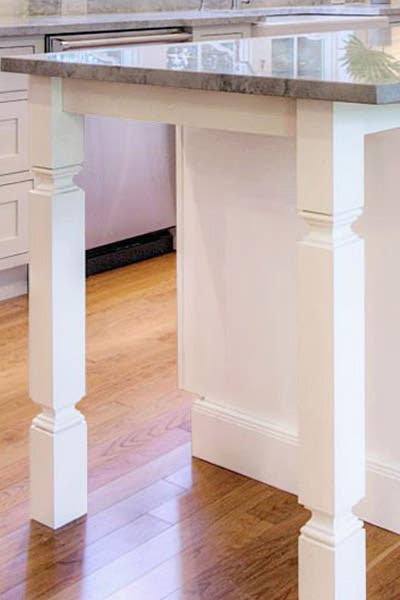A Guide to Choosing the Perfect Legs For Kitchen Area Island for Your Home
Picking the ideal legs for your kitchen island is a nuanced choice that influences both the capability and visual appeal of this central area. As you consider these elements, it ends up being apparent that the right legs can change not only the appearance of your kitchen yet likewise its functionality for years to come.

Comprehending Kitchen Island Legs
When picking legs for a kitchen island, it's crucial to comprehend their useful and aesthetic functions in the total design. The legs work as a crucial support group, making certain stability and toughness for the island, which frequently works as a work space, dining area, or collecting place. Therefore, the option of product and construction technique need to be durable adequate to withstand everyday use and prospective wear.
Along with their architectural obligations, legs contribute dramatically to the island's aesthetic appeal. They can boost the cooking area's design, whether through standard, modern, or eclectic designs. The elevation and percentage of the legs are additionally important considerations; they have to balance with the island's countertop height while ensuring comfy seating for those utilizing the room.
Additionally, the leg layout can affect the general circulation of the cooking area. Open, ventilated leg designs can produce a sense of agility, while solid, considerable legs may communicate a more based and stable visual - Legs For Kitchen Island. Comprehending these aesthetic and practical aspects will certainly direct home owners in making informed options that enhance their cooking area's design and improve its usability
Popular Styles and Materials
The selection of legs for a kitchen island includes a variety of popular styles and materials, each offering one-of-a-kind features that can boost both capability and looks. Among the most desired styles are contemporary, rustic, and conventional. Contemporary legs commonly include smooth, minimal layouts that emphasize simpleness and tidy lines, making them excellent for modern-day cooking areas. Rustic designs, on the other hand, accept all-natural aspects and often showcase redeemed timber or distressed surfaces, adding warmth and beauty to the room. Standard legs normally show ornate details and workmanship, boosting timeless cooking area layouts.

Elevation and Stability Factors To Consider

Stability is an additional vital factor to consider. The legs of the kitchen area island should offer ample support, ensuring that the structure can hold up against daily usage without tottering or changing. Material selection plays a substantial role in security; steel legs, for circumstances, tend to supply greater stamina compared to wood. Additionally, making certain that the island is securely secured to the floor or wall surface can enhance security, especially for larger islands that might bear significant weight.
Matching Your Kitchen Area Aesthetic
Choosing the ideal legs for your kitchen island goes past capability; it also plays a substantial role in the total aesthetic of the room. When selecting legs, think about the layout style of your kitchen area. For a contemporary look, sleek steel or minimal layouts can develop a clean, contemporary vibe. On the various other hand, rustic or traditional cooking areas usually take advantage of wood legs with complex describing or a distressed coating, improving warmth and personality.
Shade is an additional crucial aspect. Legs that complement or comparison with your island's surface area and surrounding cabinetry can develop visual consistency or striking focal points. Coupling dark wood legs with a light marble countertop can include depth and interest. learn the facts here now Additionally, think about the surface of the legs; matte, shiny, or textured surfaces can significantly influence the total feel of the kitchen.
Installation and Upkeep Tips
Setting up kitchen island legs calls for cautious focus to information to guarantee both security and aesthetic allure. Begin by choosing a suitable place for your island, ensuring it is degree and has ample room for movement. If you are connecting the legs to a wall surface or making use of brackets for added assistance, use a stud finder to situate wall studs. Mark the positioning of the legs accurately before exploration.
When safeguarding the legs, use high-grade screws and, if necessary, wood adhesive for added strength. For metal legs, make sure that you are making use of suitable anchors and devices to avoid damage to your floor covering. It is advisable to look for levelness after setup, making modifications as needed to prevent tottering.
Upkeep is equally essential for durability - Legs For Kitchen Island. Consistently check the legs for any indications of wear or loosening, especially in high-traffic locations. Tidy the legs with an ideal cleaner, staying clear of unpleasant products that might damage the surface area. For wood legs, consider using a timber conditioner occasionally to keep their coating. By adhering to these installment and upkeep pointers, you can ensure that your kitchen island legs remain both aesthetically attractive and practical.
Final Thought
In verdict, choosing the appropriate legs for a kitchen area island necessitates mindful consideration of elevation, security, and aesthetic compatibility. Inevitably, thoughtful leg selection plays a critical role index in boosting both the practicality and style of the cooking area area.
When picking legs for a kitchen island, it's necessary to recognize their practical and visual duties in the overall style. Open, ventilated leg styles can produce a feeling of agility, while solid, considerable legs might share a more based and secure visual. The legs of the kitchen island must give sufficient support, making certain that the structure can endure everyday usage without shifting or wobbling.Setting up cooking area island legs calls for cautious interest to information to make certain both stability and aesthetic appeal.In final thought, choosing the proper legs for a cooking area island demands cautious consideration of height, stability, and aesthetic compatibility.